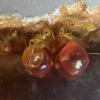- Formiculture.com
- Forums
- Gallery
- Members
- Member Map
- Chat

Camponotus modoc climbing right over fluon
Started By
Alacom
, Aug 11 2020 3:27 PM
12 replies to this topic
#1
 Offline
-
Posted August 11 2020 - 3:27 PM
Offline
-
Posted August 11 2020 - 3:27 PM
It’s basically what it sounds like but the fluon barrier is solid and not even a month old. I haven’t done anything dumb like reapply it, and it’s not humid where I live. I do live in the Central Valley though, so it does get quite hot. They don’t climb out frequently but when they are able to it scares the hell out of me since they move like lightning when they’re scared. I’m going to cover their ventilation holes with a grid or something but I still would like it if I could get some insight on why their climbing over fluon so easily.
#2
 Offline
-
Posted August 11 2020 - 3:49 PM
Offline
-
Posted August 11 2020 - 3:49 PM
Can you describe their set up? Enough humidity can come from liquid feeders and test tubes to make fluon ineffective for good climbers.
Take a look at the size of your container and how much ventilation it has.
I’ve had a lot of issues with this that I’ve documented in my Crematogaster journal posts from last summer.
Take a look at the size of your container and how much ventilation it has.
I’ve had a lot of issues with this that I’ve documented in my Crematogaster journal posts from last summer.
"The ants are a people not strong, yet they prepare their meat in the summer." Prov. 30:25
Keep ordinary ants in extraordinary ways.
Keep ordinary ants in extraordinary ways.
#3
 Offline
-
Posted August 11 2020 - 4:41 PM
Offline
-
Posted August 11 2020 - 4:41 PM
I have the same problem with all the Camponotus I've kept (pennsylvanicus and novaeboracensis). They just seem to walk right over barriers that a whole slew of Formica and Lasius can't cross. Doesn't matter how thick the layer is (a single band or an entire wall), Camponotus just seem to ignore it. I just keep Camponotus in containers or nests with lids now, and I'm extra careful when I feed. I'm assuming it has something to do with Camponotus morphology, but I honestly have no clue. Between sudden colony failure and their escape artist nature, I'm starting to wonder if I should just stick to easier ants.
You wouldn't happen to be using ByFormica fluon, would you? I don't know enough about the substance to be certain of anything, but I wonder if certain mixes work better for certain ants?
#4
 Offline
-
Posted August 11 2020 - 4:48 PM
Offline
-
Posted August 11 2020 - 4:48 PM
Try olive oil.
- TechAnt likes this
Ants I have: Tapinoma sessile(2 queen colony). RED MORPH Camponotus neacticus(now has pupae!), Tetramorium immigrans (x3), Aphaenogaster sp, Temnothorax sp, Brachymyrmex sp. possibly infertile ![]() , Ponera pennsylvanica, and Pheidole morrisi!
, Ponera pennsylvanica, and Pheidole morrisi! ![]()
Other insects: Polistes sp. Queen
Ants I need: Pheidole sp., Trachymyrmex sp., Crematogaster cerasi , Dorymyrmex sp. Most wanted: Pheidole morrisii
#5
 Offline
-
Posted August 11 2020 - 10:44 PM
Offline
-
Posted August 11 2020 - 10:44 PM
Can you describe their set up? Enough humidity can come from liquid feeders and test tubes to make fluon ineffective for good climbers.
Take a look at the size of your container and how much ventilation it has.
I’ve had a lot of issues with this that I’ve documented in my Crematogaster journal posts from last summer.
They’re in a 2.25”^3 acrylic box wit a fluon band around the top. I feed them with a drop of honey on a piece of paper
#6
 Offline
-
Posted August 12 2020 - 3:04 AM
Offline
-
Posted August 12 2020 - 3:04 AM
So, that sounds like the foraging area of a mini-hearth, or are they in something different? How big is the colony? A multitude of ants in the outworld generates its own humidity. I’d say try a larger foraging container with very good ventilation. If you can, try to make a rim around the top and line the underside of that with fluon. I doubt heavy ants could get past that.
"The ants are a people not strong, yet they prepare their meat in the summer." Prov. 30:25
Keep ordinary ants in extraordinary ways.
Keep ordinary ants in extraordinary ways.
#7
 Offline
-
Posted August 12 2020 - 4:41 AM
Offline
-
Posted August 12 2020 - 4:41 AM
So, that sounds like the foraging area of a mini-hearth, or are they in something different? How big is the colony? A multitude of ants in the outworld generates its own humidity. I’d say try a larger foraging container with very good ventilation. If you can, try to make a rim around the top and line the underside of that with fluon. I doubt heavy ants could get past that.
Right now I have three colonies right next to each other all with the same set up with around 4-8 workers. I made the mini outworld myself with boxes I got on amazon and drilled holes into them for the test tubes. I’ll try the fluon on the underside of the lid and put more ventilation holes. Thanks
#8
 Offline
-
Posted August 12 2020 - 6:15 AM
Offline
-
Posted August 12 2020 - 6:15 AM
I found baby powder to be effective against pennsylvanicus, for a time. This is a barrier that can be reapplied. It needs to be thick to hold them back, however.
"God made..... all the creatures that move along the ground according to their kinds (including ants). And God saw that it was good. Genesis 1:25 NIV version
Keeping:
Formica cf. pallidefulva, cf. incerta, cf. argentea
Formica cf. aserva, cf. subintegra
Myrmica sp.
Lasius neoniger, brevicornis
#9
 Offline
-
Posted August 12 2020 - 7:10 AM
Offline
-
Posted August 12 2020 - 7:10 AM
I'm also having the same problem with my Modocs. It's most likely because of my garbage fluon applying skills. But the Modocs never get in the way when I try to feed. What fluon do you use by the way? I use Aus Ants PTFE and I don't find it as effective as other fluon brands.
#10
 Offline
-
Posted August 13 2020 - 2:47 AM
Offline
-
Posted August 13 2020 - 2:47 AM
I'm also having the same problem with my Modocs. It's most likely because of my garbage fluon applying skills. But the Modocs never get in the way when I try to feed. What fluon do you use by the way? I use Aus Ants PTFE and I don't find it as effective as other fluon brands.
I use ByFormica. The thing is whenever I’m watching them trying to climb up it looks like they’re slipping but they’ll randomly be able to get footing every now and then.
#11
 Offline
-
Posted August 13 2020 - 6:41 AM
Offline
-
Posted August 13 2020 - 6:41 AM
AntWorldUSA has some fluon they sell as well. Pretty reasonably priced. I ordered some. Hopefully works well.
https://formicariums...=20006933889078
Currently keeping Tetramorium Immigrans and Camponotus Pennsylvanicus in THA mini hearths. I also have a couple Prenolepis Imparus queens in test tubes.
#12
 Offline
-
Posted August 13 2020 - 10:56 AM
Offline
-
Posted August 13 2020 - 10:56 AM
I have the same problem with all the Camponotus I've kept (pennsylvanicus and novaeboracensis). They just seem to walk right over barriers that a whole slew of Formica and Lasius can't cross. Doesn't matter how thick the layer is (a single band or an entire wall), Camponotus just seem to ignore it. I just keep Camponotus in containers or nests with lids now, and I'm extra careful when I feed. I'm assuming it has something to do with Camponotus morphology, but I honestly have no clue. Between sudden colony failure and their escape artist nature, I'm starting to wonder if I should just stick to easier ants.
You wouldn't happen to be using ByFormica fluon, would you? I don't know enough about the substance to be certain of anything, but I wonder if certain mixes work better for certain ants?
People say camponotous is a beginner species, but along with Formica I think they are the most difficult of the "beginner" species, between the sudden the die offs, their lazy nature, and their speed.
- ANTdrew and DDD101DDD like this
Check out my Youtube Channel! https://www.youtube....xh-HaScAuE5CShQ
Check out my Crematogaster Journal! https://www.formicul...e-2#entry141180
#13
 Offline
-
Posted August 13 2020 - 4:26 PM
Offline
-
Posted August 13 2020 - 4:26 PM
I've had the same problem in the past with all my ants. I theorized it could do with a few pieces of already cured fluon floating around in the liquid version, so I strained the liquid and transferred it to a new bottle. Seemed to work fine after that, with correct application none of my ants can cross. Another thing I did differently is to tilt the container itself for the initial application, letting the liquid roll around the tops of the walls(blocked from falling off by my finger pressed against the side) and leaving behind a trail of pristine fluon that dried.
1 user(s) are reading this topic
0 members, 1 guests, 0 anonymous users





















